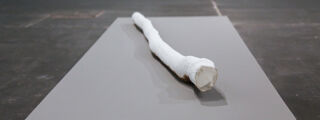Liu Jianhua was born in 1962, in Ji’an, China. He began his career in 1977 by working at the Jingdezhen Pottery and Porcelain Sculpture Factory. In 1985, he was admitted to the Fine Arts Department of the Jingdezhen Pottery and Porcelain College, majoring in Sculpture.
Biography
After graduating in 1989, Liu went on to teach at the College of Fine Arts at the Yunnan Institute of the Arts. Since 2004, Liu has been a professor in the Sculpture Department of the Fine Arts School of Shanghai University. Creating sculpture and installations in porcelain, found objects, and other materials, Liu’s work responds to Chinese culture and material history within the context of globalization. Liu, together with artists Hong Hao, Xiao Yu, Song Dong, and curator Leng Lin, established the Polit-Sheer-Form Office group in 2005.
Exhibitions
His recent solo exhibitions include Transfer (Dowse Museum, Wellington, New Zealand, 2016); Polit-Sheer-Form Meeting (Taikang Space, Beijing, 2015); Between (Pace London, 2015); Polit-Sheer-Form! (Queens Museum, U.S.A., 2014); and Screaming Walls (Ullens Center for Contemporary Art, Beijing, 2011). His recent group exhibitions include Trace (Victoria & Albert Museum, London, 2016); Collection Displays: Between Object and Architecture (Tate Modern, London, 2016); Collected Letters (San Francisco Asian Art Museum, 2016); Utopias/Heterotopia - Wuzhen International Contemporary Art Exhibition (Wuzhen, China, 2016); and The Sixth Echigo-Tsumari Art Triennale 2015 (Niigata-ken, Japan, 2015).
Rime and Filled
Ceramics have always formed the basis of Liu Jianhua’s language. By means of ancient firing techniques, he structures and gives voice to his comprehension of today’s society. When a certain material becomes part of contemporary artistic language, this language isn’t only built with the material itself, as the ‘vocabulary’, which could be dazzling and ornate, as well as simple and un-sophisticated; more importantly, the rules governing the intangibles resulting from the traditional craft and production process are what constitute the ‘grammar’ of this language. The exhibited works Rime and Filled each explore the limits of craft techniques within the domain of a traditional ‘grammar,’ as they convert minute changes observed in the realms of nature or everyday life into an aesthetic form, and thereby shape the artist’s personal and specific language system. From a superficial point of view, the first work appears to be a very ordinary tree branch, at the surface of which the cold weather seems to have resulted in the appearance of snow or frost, or indeed a poetic line of scholarly writing; as for the second one, it brings to mind a bowl overflowing with crystal-clear spring water, as if disturbed for an instant, its surface still moving with ripples. However, be it wood or water, in either case matter has been transmuted into a story unfolded in the ‘language of ceramics’.
